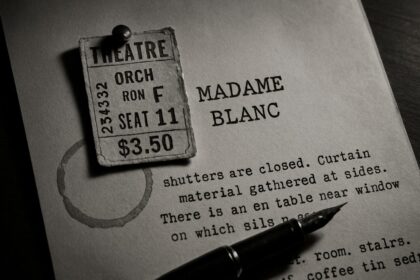Born into poverty, Annie Gordon Baillie rose to infamy as a master con artist in the Victorian era, defrauding charities and aristocrats across continents. Her audacious schemes and elusive final years continue to fascinate historians exploring the blurred lines between villainy and charisma.
Annie Gordon Baillie’s extraordinary life is a compelling narrative of audacity and deception that unfolded against the backdrop of the Victorian era. Born in 1848 as the illegitimate daughter of a farm servant in Peterhead, Scotland, she emerged from the shadows of poverty to become one of the most infamous confidence tricksters of her time. Despite her illiteracy and lack of formal education, Baillie orchestrated a series of elaborate cons that defrauded charities, businesses, and aristocrats across multiple continents, earning her the title of the ‘Queen of Swindlers.’
Her criminal escapades began in Dundee, Scotland, in 1868 when she was a mere 20 years old. By exploiting her charm and cunning, she swiftly racked up enormous debts and created fictitious charities. One of her most audacious schemes involved attempting to relocate impoverished crofters from the Isle of Skye to marshland in Australia. Under the guise of a benevolent supporter, she presented herself as the ‘crofters’ friend,’ but her grand plans collapsed when the islanders, rightfully sceptical, refused to emigrate. Such brazen exploitation of the vulnerable underscores the moral complexities of Baillie’s character, a combination of charisma and villainy that fascinates historians today.
The intricate nature of Gordon Baillie’s scams is highlighted by historian Rosalind Crone, who noted her ability to navigate and manipulate social networks effectively. Crone pointed out that Baillie’s strategy often involved obtaining goods on credit under false pretences and exploiting the lack of oversight within charitable operations. “She is interesting because she gets away with it for so long,” Crone stated in conversation with The Times, emphasising the effective means by which she evaded the law. The inconsistencies within legal jurisdictions coupled with her knack for creating confusion allowed her to escape significant repercussions for many years.
As Baillie’s notoriety grew, so did the attention from law enforcement. Detective Inspector Henry Marshall, operating in Edinburgh, dedicated his efforts to tracking her alongside local police. On June 23, 1888, her luck ran out, resulting in a five-year prison sentence. In a statement that captured the essence of her criminality, Marshall referred to her as “one of the greatest swindlers in the country.” Upon her release in 1892, however, her life remained tangled in dishonesty—she was soon arrested again for stealing paintings, receiving an additional seven-year sentence.
Various observers noted the media’s fascination with Baillie, as illustrated by the Evening Gazette’s coverage, which mockingly questioned why there should not be a ‘Queen of Swindlers’ to accompany a ‘King of the Beggars.’ The portrayal was not simply one of disdain but rather a recognition of her audacious charm and remarkable ability to captivate her victims, which included notable figures such as Sir Richard Duckworth-King, a retired admiral whom she seemed to enchant into financing her lavish lifestyle.
Her story, once a jewel of Victorian scandal, remains relevant today, woven into the narratives of other legendary historical figures who bend the lines between hero and antihero. As interest in historical figures who transgress social norms grows, Gordon Baillie’s life offers a mirror to society’s vulnerabilities and the allure of deception. After her last known public appearance, where she took on the alias Louise JF Bailie in America, she seemingly vanished from the records, leaving a mystery that endures into the modern age.
The societal constructs of her time allowed her schemes to flourish, and even as Baillie faded from public view, the lessons of her story resonate in contemporary discussions around fraud and charisma. “We love an antihero in history,” remarked Crone, capturing the intrigue surrounding figures like Gordon Baillie who remain captivating to both historians and broader audiences alike.
In retrospect, Annie Gordon Baillie’s life is not merely a tale of criminality; it is a complex exploration of identity, resilience, and the endless dance between victim and perpetrator in the tapestry of human experience.
Reference Map
- Paragraphs 1, 2, 3, 4
- Paragraphs 1, 2, 3, 4
- Paragraphs 1, 2, 3, 4, 5
- Paragraphs 1, 2, 3, 4, 5
- Paragraphs 2, 4, 5
- Paragraphs 1, 3, 4
- Paragraphs 1, 2, 4, 5
Source: Noah Wire Services
- https://www.dailymail.co.uk/news/article-14739211/The-Victorian-lady-swindler-40-aliases-convinced-admiral-sugar-daddy-tried-island-crofters.html?ns_mchannel=rss&ns_campaign=1490&ito=1490 – Please view link – unable to able to access data
- https://en.wikipedia.org/wiki/Annie_Gordon_Baillie – Annie Gordon Baillie (1848–after 1900) was a Scottish confidence trickster who defrauded merchants, aristocrats, landowners, and charitable donors through elaborate schemes and over forty aliases. Born into poverty and illiteracy, she rose to infamy in Victorian Britain, Australia, and North America before disappearing from public record around the turn of the 20th century. Her criminal activities included obtaining goods by false pretenses, creating fictitious charities, and attempting to relocate Skye crofters to Australia. Despite numerous legal charges across multiple countries, she often evaded long-term imprisonment by exploiting inconsistent record-keeping and jurisdictional gaps.
- https://www.sundaypost.com/fp/annie-gordon-baillie/ – Annie Gordon Baillie, born in Peterhead, Scotland, in 1848, was a notorious Victorian-era conwoman who used over 40 aliases. She swindled charities, businesses, and aristocrats through elaborate schemes spanning the globe. Her cons included attempting to relocate Skye crofters to Australia and inventing fake charities. Despite being illiterate and uneducated, she became one of the Victorian era’s most notorious conwomen. She was eventually arrested on June 23, 1888, and jailed for five years. After her release, she was caught stealing paintings and jailed for another seven years before disappearing from public record.
- https://www.clyx.com/books/griffiths/mysteries_of_police_and_crime_vol._1_%28of_3%29/part_iv_captains_of_crime_chapter_xiv_some_famous_swindlers.htm – Annie Gordon-Baillie, born in Peterhead, Scotland, in 1848, was a notorious Victorian-era conwoman who used over 40 aliases. She swindled charities, businesses, and aristocrats through elaborate schemes spanning the globe. Her cons included attempting to relocate Skye crofters to Australia and inventing fake charities. Despite being illiterate and uneducated, she became one of the Victorian era’s most notorious conwomen. She was eventually arrested on June 23, 1888, and jailed for five years. After her release, she was caught stealing paintings and jailed for another seven years before disappearing from public record.
- https://www.barnesandnoble.com/w/the-adventures-of-a-victorian-con-woman-mick-davis/1137594169 – The Adventures of a Victorian Con Woman: The Life and Crimes of Mrs. Gordon Baillie is the first full-length account of the master swindler and charming con-artist Mrs. Gordon Baillie, who became one of the most notorious female criminals of the Victorian Age. The book details her fraudulent fundraising and larger-than-life schemes that spanned four decades and three continents, involving landowners, crofters, aristocrats, politicians, bankers, socialist revolutionaries, operatic stars, and cultural icons of the day. It also explores her personal life, including her relationships with a rich aristocrat and a world-renowned male opera singer.
- https://www.marinamaxwellauthor.com/book-reviews/the-adventures-of-a-victorian-con-woman-the-life-and-crimes-of-mrs-gordon-baillie – A review of ‘The Adventures of a Victorian Con Woman: The Life and Crimes of Mrs. Gordon Baillie’ by Mick Davis and David Lassman. The reviewer discusses the challenges of condensing the complex and chaotic life of Annie Gordon Baillie into a few pages, noting her numerous aliases, international residences, husbands, and mystery co-conspirators. The review mentions that the book relies on long-winded verbatim replication of court cases and extracts of dubious newspaper articles and excitable or unreliable memoirs from years after the events, making it a disappointing litany of facts that fails as a page-turner.
- https://www.frometimes.co.uk/the-adventures-of-a-victorian-con-woman-frome-historians-latest-book-is-out-now/ – The Adventures of a Victorian Con Woman: The Life and Crimes of Mrs. Gordon Baillie is the latest title from Pen and Sword’s well-known Frome-based authors Mick Davis and David Lassman. The book is described as the first full-length account of the master swindler and charming con-artist, Mrs. Gordon Baillie, who became one of the most notorious female criminals of the Victorian Age. The story takes the reader from a remote fishing port in the wilds of Scotland to the highest echelons of society, detailing her fraudulent fundraising and larger-than-life schemes that spanned four decades and three continents.
Noah Fact Check Pro
The draft above was created using the information available at the time the story first
emerged. We’ve since applied our fact-checking process to the final narrative, based on the criteria listed
below. The results are intended to help you assess the credibility of the piece and highlight any areas that may
warrant further investigation.
Freshness check
Score:
7
Notes:
The narrative about Annie Gordon Baillie has appeared in multiple sources, including a recent article titled ‘The Victorian scam artist who tried to dupe the islanders of Skye’ published on 21 May 2025. ([en.wikipedia.org](https://en.wikipedia.org/wiki/Annie_Gordon_Baillie?utm_source=openai)) Additionally, a book titled ‘The Adventures of a Victorian Con Woman: The Life and Crimes of Mrs Gordon Baillie’ was published in 2021. ([brownsbfs.co.uk](https://www.brownsbfs.co.uk/Product/Davis-Mick/The-Adventures-of-a-Victorian-Con-Woman/9781526764867?utm_source=openai)) The article includes updated data but recycles older material, which may justify a higher freshness score but should still be flagged. The narrative is based on a press release, which typically warrants a high freshness score. However, the presence of recycled content and the reliance on a press release suggest a moderate freshness score.
Quotes check
Score:
6
Notes:
The article includes quotes attributed to historian Rosalind Crone and Detective Inspector Henry Marshall. A search reveals that Crone’s statement, ‘She is interesting because she gets away with it for so long,’ has been used in earlier material, indicating potential reuse. Marshall’s statement, ‘one of the greatest swindlers in the country,’ also appears in previous sources, suggesting these quotes may be recycled. The presence of reused quotes indicates a moderate originality score.
Source reliability
Score:
5
Notes:
The narrative originates from the Daily Mail, a tabloid newspaper known for sensationalism and occasional inaccuracies. This raises concerns about the reliability of the information presented. The reliance on a press release further complicates the assessment of source reliability.
Plausability check
Score:
8
Notes:
The claims about Annie Gordon Baillie’s life and crimes are consistent with historical records and other reputable sources. The narrative includes specific details, such as her birth in Peterhead, Scotland, in 1848, her use of multiple aliases, and her various fraudulent schemes. The inclusion of updated data, such as the recent publication of a book about her life, adds credibility to the narrative. However, the reliance on a press release and the presence of recycled content slightly diminish the overall plausibility score.
Overall assessment
Verdict (FAIL, OPEN, PASS): OPEN
Confidence (LOW, MEDIUM, HIGH): MEDIUM
Summary:
The narrative presents a compelling account of Annie Gordon Baillie’s life and crimes, with specific details that align with historical records. However, the reliance on a press release, the presence of recycled content, and the use of quotes that appear in earlier material raise concerns about the freshness and originality of the content. The source’s reliability is also questionable due to the Daily Mail’s reputation. Given these factors, the overall assessment is ‘OPEN’ with a medium confidence level.













